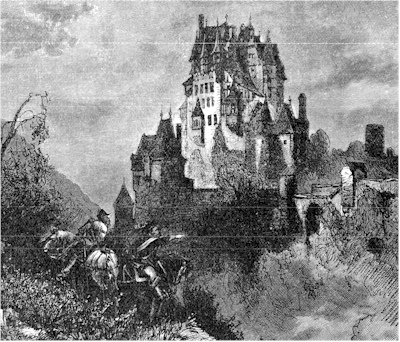Lippincott's Magazine
OF
POPULAR LITERATURE AND SCIENCE.
Vol. XX.
AUGUST, 1877.
Entered according to Act of Congress, in the year 1877, by J. B.Lippincott & Co., in the Office of the Librarian of Congress, atWashington.
DOWN THE RHINE.
CONCLUDING PAPER.
Coblenz is the place which many years ago gave me my first associationswith the Rhine. From a neighboring town we often drove to Coblenz, and thewide, calm flow of the river, the low, massive bridge of boats and the[Pg 138]commonplace outskirts of a busy city contributed to make up a verydifferent picture from that of the poetic "castled" Rhine of German songand English ballad. The old town has, however, many beauties, though itsmilitary character looks out through most of them, and reminds us that theMosel city (for it originally stood only on that river, and then crept upto the Rhine), though a point of union in Nature, has been for ages, sofar as mankind was concerned, a point of defence and watching. The greatfortress, a German Gibraltar, hangs over the river and sets its teeth inthe face of the opposite shore: all the foreign element in the town is dueto the deposits made there by troubles in other countries, revolution andwar sending their exiles, émigrés and prisoners. The history of the townis only a long military record, from the days of the archbishops ofTrèves, to whom it was subject, to those of the last war. It has, however,some pleasanter points: it has long been a favorite summer residence ofthe empress of Germany, who not long before I was there had by her tactand toleration reconciled sundry religious differences that threatened apolitical storm. Such toleration has gone out of fashion now, and thepeacemaking queen would have a harder task to perform now that the twoparties have come to an open collision. There is the old "German house" bythe bank of the Mosel, a building little altered outwardly since thefourteenth century, now used as a food-magazine for the troops. The churchof St. Castor commemorates a holy hermit who lived and preached to theheathen in the eighth century, and also covers the grave and monument ofthe founder of the "Mouse" at Wellmich, the warlike Kuno of Falkenstein,archbishop of Trèves. The Exchange, once a court of justice, has changedless startlingly, and its proportions are much the same as of old; andbesides these there are other buildings worth noticing, though not so old,and rather distinguished by the men who lived and died there, or were bornthere, such as Metternich, than by architectural beauties. Such housesthere are in every old city. They do not invite you to go in and admirethem: every tourist you meet does not ask you how you liked them orwhether you saw them. They are homes, and sealed to you as such, butthey are the shell of the real life of the country; and they have somehowa charm and a fascination that no public building or show-place can have.Goethe, who turned his life-experiences i
